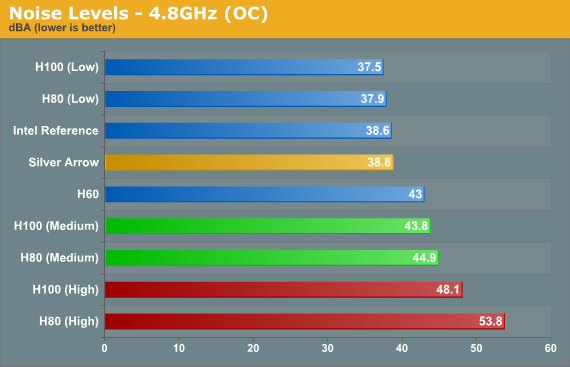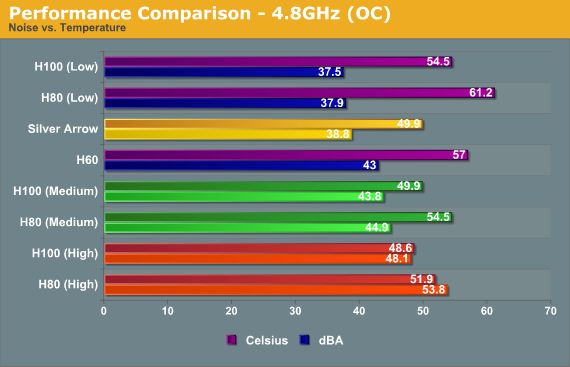Corsair Hydro Series: H60, H80 and H100 Reviewed
by Jared Bell on November 7, 2011 12:00 AM EST- Posted in
- Cases/Cooling/PSUs
- Corsair
- Water Cooling
Noise Results
Due to the built-in variable fan controller on the H80 and H100, testing the noise on these two coolers proved to be challenging. Our test system, even when overclocked to 4.8GHz, didn't generate enough heat to max out the RPM on the H100 high speed test. When plugged into a direct power source, the H100 fans were barely, but noticeably, louder than when powered by the controller on the high setting. We opted to power the fans as intended using the built-in fan controller, but it should be noted that these fans could be slightly louder if directly powered or used in a hotter system/environment. The H80 appears to hit max RPM on all tests, while the H60 is forced to 100% with it having the only PWM fan in the bunch.

The H100 and H80 when set on low speed are neck and neck for the quietest coolers of the bunch, beating even the virtually silent Silver Arrow and Intel reference cooler. The H60 with its slower RPM fan barely edges out the H100 and H80 when they're set to medium. The H100 and H80 when set on high speed top the charts here, as we would expect. While the H80 and H100 sport the same fans, but the H100 comes in quieter. This is most likely due to our test system not being hot enough for the H100's fans to fully kick in.
Here we finally see the penalty for the excellent cooling capability of the H100 when it's running on high speed. As you can see, it's quite loud at this setting. Let's take a look at the noise graph again, but this time we'll overlay the temperature graph to get a better idea on how nose and performance are related.

For the most part, the better the performance, the louder the cooler. Ultimately, it's up to you to decide what the perfect balance of cooling performance and noise acceptance is for your particular situation.










91 Comments
View All Comments
bakedpatato - Monday, November 7, 2011 - link
Good article; I now know that it's probably not worth it to replace my Xigmatek Dark Knight pre sandy bridge model because there's not that much of a performance delta.On that note, why do the big honking air coolers consistently outperform the sealed water cooling units?
LoneWolf15 - Monday, November 7, 2011 - link
"On that note, why do the big honking air coolers consistently outperform the sealed water cooling units?"I'm guessing that the following limits hurt sealed H2O units, limiting their ability to compete.
-Limited amount of liquid (as opposed to a system with a reservoir that would allow fluid to cool more easily during the cycle)
-Limited volume of liquid that can be carried by sealed units tubing (both due to limited tubing diameter and the limited amount of liquid)
Also, if you have that reservoir and larger diameter tubing, you can use a higher volume pump to deliver cool liquid faster. None of these are easy to do for a sealed kit, because it increases expense and reduces reliability. These limits prevent sealed systems from greatly exceeding the performance of quality air coolers.
Death666Angel - Monday, November 7, 2011 - link
Unless your reservoir is in the region of several tens or hundreds of litres, the reservoir serves no cooling purpose. In sealed cooling solutions, you don't need it because of the sealed nature (at least if the manufacturer does its job of delivering an air-free system and handles loss of liquid due to dissipation from the tubes adequately). In open/standard water cooling you need it in order to fill and refill your cycle, to have a spot where the air can escape the system, to gauge if enough water is in the system or to get an estimate of the circulation (bubbling water can mean high circulation, flat surface can mean low etc.).Once a water cooling solution reaches a certain amount of water flow, increasing the amount will not help the cooling in any way, so the limited flow in these units does not negatively contribute to its lack of performance.
You also make it seem as though these units use water to cool. That is false. They use air to cool, the water only transports the heat from the generator (CPU) to the radiator. Standard air cooling just cuts out the middleman (water).
So your reasons are all false, I'm sorry to say.
It boils down to simple thermodynamics. Look at the surface that these Corsair radiators provide for cool and then compare them to that Thermalright monster and you have your reason for why they don't do better.
The reason DIY watercooling is so high end is because usually they have at least twice to three times the radiator surface compared to the H100. People with SLI/CF configurations usually go for a MoRa which has 9*120/140mm fans and the respective radiator surface to go along with it. But these tiny 120mm or 240mm radiators used by Corsair do not greatly increase the surface that is available for cooling.
Also, geometry plays a role in cooling. In order to increase surface in the same dimensions, you can make the fins be more narrow, thus having more fins in the same space. This then influences the air flow through the fins. So narrow fins can be better at high air flow (provided by more powerful/louder fans) or less narrow fins can be used in order to obtain a passive or low-rpm cooling method, which is less powerful.
(English is my 2nd language so I'm not sure I use all words 100% correctly. Hope I'm understandable.)
JarredWalton - Monday, November 7, 2011 - link
"People with SLI/CF configurations usually go for a MoRa which has 9*120/140mm fans and the respective radiator surface to go along with it."Seriously? I've seen plenty of water cooling solutions over the years, but I have never seen anyone with an apparently 360x360mm radiator and nine fans (let alone a 420x420mm radiator with nine 140mm fans). I'm sure that some extreme water-cooling types go for this sort of setup, but I'd wager far more are using 120x240mm radiators, if simply for the fact that most cases won't easily accommodate a larger radiator. If you go with an external radiator tower, sure, you can have a larger setup, but then you really never plan on moving your PC. Other than that, though, I'd agree: it's about surface area, and that Thermalright Silver Arrow is a monster.
Death666Angel - Monday, November 7, 2011 - link
Look through the water cooling forums (one I frequently use is this: http://www.hardwareluxx.de/community/f137/), look especially at the picture threads.People who only cool their CPU might go with a 240 setup, but that doesn't really work more quietly, more efficient, cheaper or easier than simple air cooling, as you have shown. So the people who invest the time and money to get water cooling going usually start with a 360 radiator or 420, depending on the case. They can be easily integrated in the usual water cooling cases that get recommended. People who go with SLI/CF will either get 2*360 (or similar), 420+280 (one in the bottom/top, one in the front) or make it easier and mount a 1080/1260 either externally on a side panel or use an external stand. The additional cost of more/bigger radiators is also easily offset, since the base components can remain (CPU heatsink, tubes and fittings/connectors, pump...).
For my first water cooling I'm going with a 480 (2x2 120mm) radiator mounted on one side of the TJ08-E, which might get expanded to 2*480 once I start cooling my GPU (not going to buy a new card before the 28nm generation and my HD5770 is fine with air for now).
Of course, my sampling of the water cooling community is limited and there might be a lot of people who don't frequent special forums. But I personally doubt it, since you do need kind of a lot of knowledge about the right tubes, fittings, sizes, water components etc. And the newbies who as in those forums and want to go with "just a little water cooling for the noise" usually get recommended (and convinced of) good air coolers like the Silver Arrow. :-)
sticks435 - Monday, November 7, 2011 - link
I would look in the water cooling threads at overclock.net instead. Most people recommend a 120x3 for an overclocked CPU and GPU, and a 120x4 for an extra GPU. Maybe if you were running Triple or Quad SLI/CF you might need something like what you mentioned, but that is definitely the exception instead of the norm.Death666Angel - Monday, November 7, 2011 - link
Maybe if it is a high-end radiator or noise isn't that important. But like this review shows, a high end air cooler already competes with one 240mm radiator. And a CPU only uses between 100W and 150W depending on the overclock, whereas a GPU even at stock uses 200-250W. Using only one 360 radiator for a setup that can use 300-400W sounds very noisy and it looks as though air cooling could do a better job then, 2*140mm fans heatsink for CPU and triple 80mm fans for GPU for example are relatively easy to come by, fit in most cases more easily than a whole water cooling kit. :-)Death666Angel - Monday, November 7, 2011 - link
But, to nip this discussion in the butt: unfortunately neither of us have any real data, so we can only go off our instinct and experience so far. Yours is different from mine, no sense arguing that. :DEtsp - Monday, November 7, 2011 - link
to nip this discussion in the bud*FTFY
n13L5 - Monday, August 27, 2012 - link
If I had a big case that could fit a silver arrow, I certainly wouldn't even be looking at these water things. Cause they are risky by comparison... a pipe could bust and flood the computer with whatever corrosive liquid is in there etc...But if you have a small case that has little room above the mainboard, these little systems don't need to beat the silver arrow at all... even the H60 will easily beat anything I could fit over the CPU in an SG05 or a PC-Q08 case. And, the heat goes straight out of the case, not spread around inside the case. I don't know if this test took into account that the mightly Silver Arrow just removes the heat from the CPU but not from the case.